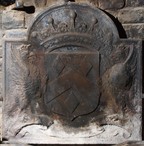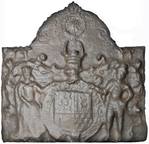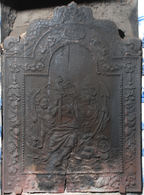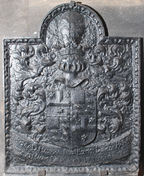-
1029
Description: Arched rectangular shape; cavetto-moulded edging; shield, supporters, earl's coronet and motto scroll.
Notes: The arms are of the Hyde family: azure, a chevron between three lozenges or; the supporters: two eagles, wings endorsed sable, ducally crowned and charged on the breast with a cross or; Edward Hyde (1609-74) was created earl of Clarendon in 1661. An excrescence over the sinister supporter indicates where the iron was poured clumsily into the open sand mould.
Arms: Hyde, earls of Clarendon
- Decoration tags:
- rectangular with round arch (shape)
- cavetto (edging)
- whole carved pattern
- heraldic
- armorial
Manufactured: in the mid- to late-17th century in England.
Current location: The Lygon Arms, High Street, Broadway, Worcestershire, England.
- Attached to series:
- Personal armorial firebacks
-
1259
Description: Plain rectangular plate; shield, garter, helm, mantling and supporters of the Blount family, Lords Mountjoy; above, a Garter enclosing a sun charged with an eye, all surmounted by an earl's coronet; decorative edging of the arch in low relief.
Notes: The arms are those of Charles Blount, 8th Baron Mountjoy (1563-1606), who was invested Knight of the Garter in 1597. He was created 1st Earl of Devonshire in 1603 and the original fireback, of which this is probably a copy, therefore dates from between 1603 and 1606. Blazon: 1. (Blount) Barry nebuly of six Or and Sable; 2. (Ayala) Argent, two wolves passant Sable on a bordure of the first eight saltires Gules; 3. (Mountjoy) Or a tower Azure; 4. (Gresley) Vair. The fireback was made by taking a worn casting of the Mountjoy arms (for a clearer example see no. 740) and using it as a pattern, adding an extension above with the decorative edging and the crowned Garter and sun, the detail of which is sharper than the armorial below. The Garter and sun as a badge of Charles Blount has been noted on two contemporary book bindings. The fireback may have come from Dedisham Manor in West Sussex, which belonged to a cadet branch of the Blount family from 1545 to 1636 and which, in the latter year, was sold to Richard Onslow who later built Clandon Park.
Inscription: Garter motto [mostly illegible]
Arms: Charles Blount, KG, 8th Baron Mountjoy, Earl of Devonshire
- Decoration tags:
- rectangular with round arch (shape)
- none (edging)
- carved stamps
- whole carved pattern
- heraldic
- armorial
Manufactured: in the early-17th century possibly at Dedisham Furnace, Rudgwick in the Weald area of England.
Current location: Clandon Park, West Clandon, Surrey, England.
Museum number: 1441937 (part of the National Trust museum group)
- Attached to series:
- Personal armorial firebacks
- Mountjoy series
-
42
Description: Arched rectangular shaped central panel with bead edging; pictorial scene of a seated female figure resting against a hurdle, holding an anchor, a child on each side of her, the one on the left standing clutching corn stalks, the one on the right sitting also holding the anchor and a circular object; a bird sits on a post; arched rectangular shaped border with fillet edging, containing floral swags suspended from a wreath; on top, a scallop shell between two dolphins.
Notes: The figure represents Hope. The theft in 1699 from a Thames-side warehouse of several firebacks, including '3 of Hope with an Anchor' may refer to this type (Post Boy 11-14 Nov. 1699).
Copies of this fireback are known.
- Decoration tags:
- 'Dutch' (shape)
- fillet (edging)
- whole carved pattern
- pictorial
- allegorical
- animals
- humans
- objects
Manufactured: in the mid- to late-17th century in the Siegerland area of Germany.
Current location: in private hands, Cuckfield, West Sussex, England.
- Attached to series:
- 'Dutch' Miscellaneous Firebacks
- Hope firebacks
-
424
Description: Arched rectangular central panel with bead edging terminating at the top in two loops, gather drapery and a scallop shell; two figures to the right, both bearded, the one kneeling wears cavalry armour, a cloak and a crown, the other stands behind; to the left is a sacrificial pyre on which an ox carcass burns, and above an angel carrying a sword in his right hand and a skull in his left; around this is an arched rectangular border with fillet edging and a repeated leaf pattern; on top is a scallop shell between two dolphins.
Notes: The scene illustrates the visitation of the pestilence on Israel described in 2 Samuel 24, and the sacrifice of an oxen by King David; the skull borne by the angel represents the death of those struck down by the plague. A slightly different version has the face of David looking down (no. 527). Formerly part of the J. H. Every collection.
Copies of this fireback are known.
Manufactured: in the mid- to late-17th century in the Siegerland area of Germany.
Current location: Anne of Cleves House, Southover High Street, Lewes, East Sussex, England.
Museum number: 1944.24.070 (part of the Sussex Archaeological Society museum group)
Citation: Hughes, G. B., 1960, Collecting Antiques (London, Country Life), pp. 85-93.
-
480
Description: Arched rectangle; ovolo, egg-and-dart moulded edging; shield, helm, coronet, crest and mantling; curved inscription panel below shield.
Notes: The heraldic devices on the shield, and the form of the helm and crest suggest this may be a continental achievement of arms; the style of the fireback is, however, is more characteristic of English types.
Copies of this fireback are known.
Inscription: ... D HADRIANI ... EQVITE DOM DE HE.. / ... M.. ... ... [?]
Arms: not known
- Decoration tags:
- rectangular with round arch (shape)
- egg and dart (edging)
- whole carved pattern
- planklines
- armorial
- text
Manufactured: in the early-17th century .
Current location: Maidstone Museum, St Faith's Street, Maidstone, Kent, England.
(part of the Maidstone Museum museum group)
- Attached to series:
- Personal armorial firebacks




